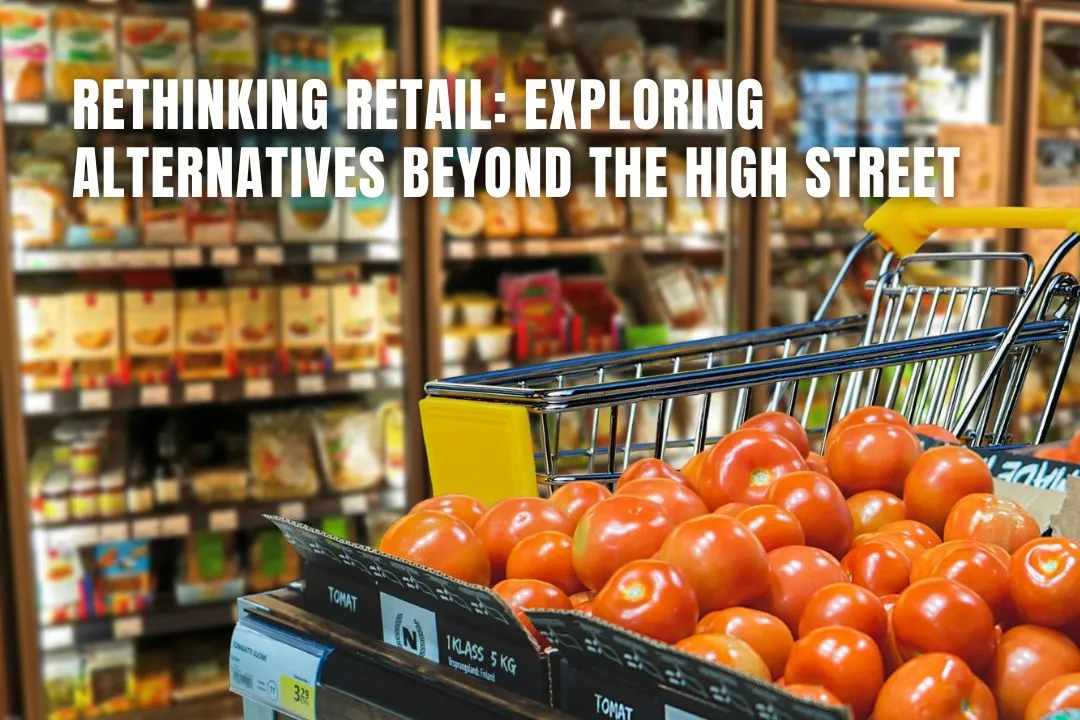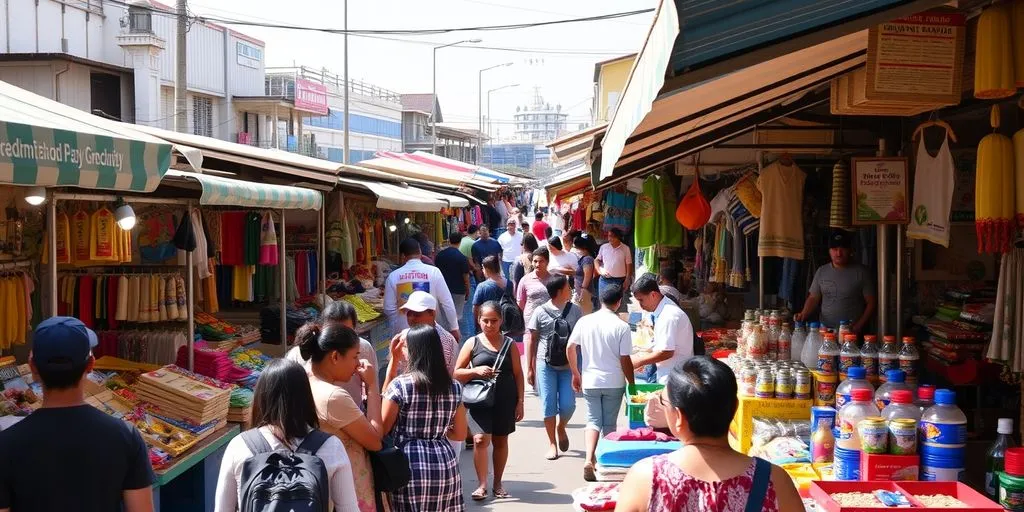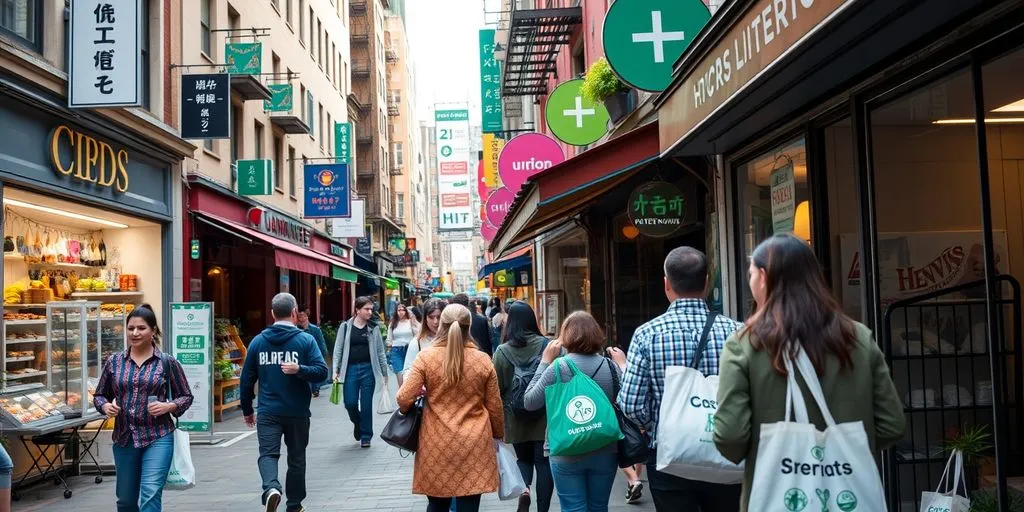September 17, 2024

The retail landscape is changing fast, pushing us to rethink the traditional high street. With the rise of online shopping and out-of-town retail parks, our shopping habits are evolving. This article explores different retail models, the role of technology, and community-focused approaches to create a more sustainable and resilient retail future.
Retail has come a long way from the traditional high street shops to the vast world of online shopping. In the 1970s, retail began to decentralise in the UK and Europe, changing the retail geographies of cities. This shift was driven by technological, organisational, and marketing changes, as well as a loosening of planning constraints. Today, small retail businesses face challenges competing with larger stores and online giants like Amazon. However, opportunities exist for them to excel in customer experience by leveraging their unique strengths.
The 1950s saw the introduction of enclosed, climate-controlled malls, which led to the rise of out-of-town retail parks. These parks became popular due to their convenience, ample parking, and a variety of stores in one location. The principle of co-location, where similar stores are grouped together, benefits both consumers and retailers. For consumers, it reduces the effort needed to shop, while for retailers, it decreases costs and shares facilities like parking.
E-commerce has had a profound impact on traditional retail. The convenience of shopping from home, a wider range of products, and often lower prices have drawn many customers away from physical stores. This shift has forced traditional retailers to rethink their strategies and adapt to the changing landscape. Despite the challenges, some retailers have successfully integrated online and offline experiences to provide a seamless shopping journey for their customers.

Pop-up shops are short-term retail spaces that allow brands to create a unique shopping experience. These shops can quickly adapt to market trends and consumer demands. They offer a low-risk way for businesses to test new products or locations. Pop-up shops are also great for creating buzz and excitement around a brand.
Experiential retail focuses on creating memorable experiences for customers. This model goes beyond just selling products; it aims to engage customers on a deeper level. Stores might offer workshops, events, or interactive displays. The goal is to make shopping more enjoyable and to build a stronger connection with the brand.
Subscription-based retail models provide customers with regular deliveries of products. This model is convenient for consumers and helps businesses maintain a steady revenue stream. It also allows for better inventory management and customer retention. Subscription services can range from monthly boxes of snacks to regular deliveries of beauty products.
In today's retail world, digital technologies are everywhere. Artificial intelligence (AI) helps shops automate tasks, making things run smoother and boosting profits. For example, AI can manage stock levels, predict what customers want, and even help with customer service. This means shops can focus more on giving customers a great experience.
Big data is like a treasure chest of information. Shops use it to learn about their customers' habits and preferences. By analysing this data, they can offer personalised deals and improve their services. This is one of the top business opportunities in the UK, as it helps shops stay ahead of the competition.
Smart solutions make retail more efficient. Things like smart shelves that track inventory or checkout-free stores where you can just grab and go are becoming more common. These innovations save time for both the shop and the customer, making shopping quicker and easier.
Technology is changing the way we shop, making it more convenient and personalised. As these innovations continue to grow, the future of retail looks bright.
Retailers are increasingly focusing on local corporate social responsibility (CSR) initiatives to build stronger ties with their communities. By engaging in activities that benefit the local area, businesses can foster a sense of loyalty and trust among residents. This approach not only enhances the company's reputation but also contributes to the overall well-being of the community.
With an ageing population, retailers have a unique opportunity to cater to the needs of older adults. By offering products and services tailored to this demographic, businesses can create a more inclusive shopping experience. This can include everything from accessible store layouts to special discounts and events aimed at seniors.
Partnership models are becoming increasingly popular as a way to bring together different stakeholders for the benefit of the community. These models can include collaborations between retailers, local governments, and non-profit organisations. By working together, these groups can create initiatives that address local needs and improve the overall shopping experience.
Community building is revamping how brands interact with their audiences. By prioritising relationships over sales, businesses are cultivating a loyal customer base.
Retail pharmacies can expand their role by engaging with the local community to support care journeys, medication adherence, and value-based outcomes.

Retailers need to be flexible to survive economic ups and downs. Building a resilient business means being ready for anything, from financial crises to sudden changes in customer habits. Shops that can quickly change their plans and find new ways to attract customers will do better in tough times.
Many shops are now focusing on being green. This means using less energy, recycling more, and selling products that are good for the planet. Customers, especially those under 30, prefer to buy from shops that care about the environment. Here are some ways shops can be more sustainable:
A strong retail community can help shops survive tough times. By working together, shops can share ideas and support each other. This can include local events, shared marketing, and group buying to save money. When shops in a community work together, they can create a better shopping experience for everyone.
A sustainable high street adapts to the changing needs and expectations of customers. Keeping up with trends and using data to understand what customers want can help shops stay relevant and successful.
Urban retail spaces are undergoing a transformation to stay relevant in today's world. This section explores how urban design, heritage, and place marketing can breathe new life into town centres.
Urban design plays a crucial role in shaping retail spaces. Good design can attract more visitors and make shopping areas more enjoyable. Mixed-use developments are becoming popular, combining shops, homes, and offices in one area. This approach helps create a sense of community and connectedness.
Heritage and place marketing are essential for revitalising urban retail landscapes. By highlighting the unique history and culture of an area, towns can attract tourists and shoppers. This not only boosts the local economy but also fosters a sense of pride among residents.
Revitalising town centres involves more than just updating buildings. It requires a holistic approach that includes improving public spaces, supporting local businesses, and hosting community events. These efforts can make town centres vibrant and attractive places to visit.
Revitalising urban retail spaces is about more than just new buildings; it's about creating a lively, welcoming environment for everyone.
UK High Streets are facing a period of turbulent change. The global economic crisis of 2007-2009 along with the development of out-of-town and online retailing have directly affected the vitality and viability of high streets, leading to store closures and unemployment. The enormity and complexity of the problem has made it difficult for high street stakeholders to respond effectively. Economic pressures have forced many businesses to shut down, leaving empty storefronts and reducing foot traffic.
Changing consumer trends, waves of retail decentralisation, and various socio-economic and environmental shocks have exacerbated the well-recognised challenges of retail-dominant English high streets in recent years. The decline and ‘death’ of the high street has been the subject of many policy responses aiming at transforming high streets as viable multifunctional hubs and local community anchors. However, this vision implies a narrative change of high street viability beyond established economic and property-oriented interpretations, which is presently unclear in conceptual and operational terms.
Taking a place management approach led to the development of a more strategic framework for regeneration, which consisted of repositioning, reinventing, rebranding and restructuring strategies (4R’s of regeneration). Collaboration with the project towns resulted in identification of the strategy area that would add the most value, and the impact of the 4R’s and the top 25 priorities is demonstrated via numerous town examples.
In conclusion, the landscape of retail is evolving rapidly, and the traditional high street must adapt to survive. The rise of online shopping and out-of-town retail centres has posed significant challenges. However, these challenges also present opportunities for innovation and reinvention. By focusing on local needs, embracing digital technologies, and fostering community engagement, high streets can become vibrant hubs once again. The future of retail lies in a balanced approach that combines the convenience of online shopping with the unique experiences that only a well-curated high street can offer. As we rethink retail, it's clear that the high street still has a vital role to play in our communities.
High streets have been affected by the rise of online shopping, the growth of out-of-town retail parks, and economic challenges. These factors have led to store closures and less foot traffic.
Online shopping offers convenience and a wider range of products, which has drawn customers away from traditional high street stores. This shift has forced many physical stores to close or adapt their business models.
Pop-up shops are temporary retail spaces that open for a short period, often to test a market or create a buzz around a product. They offer a unique shopping experience and can attract new customers.
Technology can streamline operations through digital tools, big data, and smart solutions. These innovations help retailers understand customer preferences, manage inventory better, and enhance the shopping experience.
Experiential retail goes beyond just selling products. It focuses on creating memorable shopping experiences through interactive displays, events, and personalised services to engage customers more deeply.
Retailers can engage in local corporate social responsibility initiatives, partner with community groups, and create inclusive spaces that cater to diverse populations, including the ageing community. This helps build stronger, more resilient local communities.